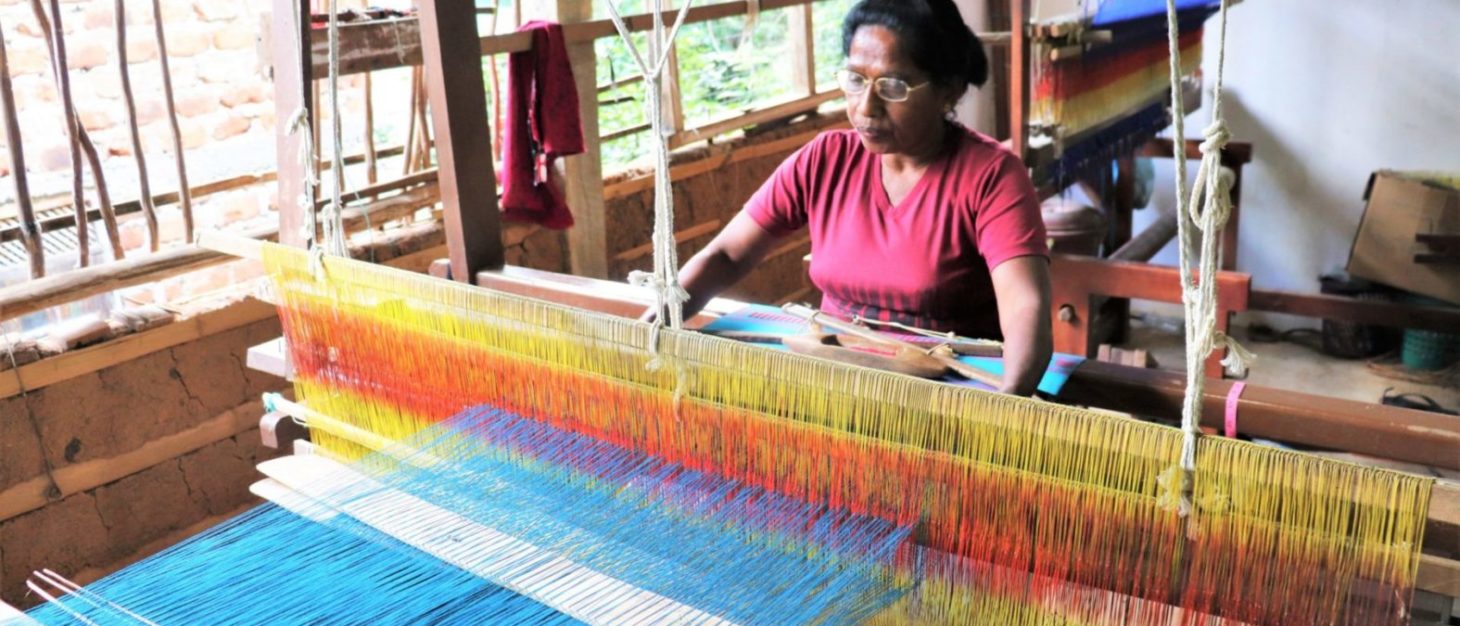The history of Sri Lanka handloom textile weaving dates back to the 6th Century BC.

History of Sri Lanka Handloom
The history of Sri Lanka handloom textile weaving dates back to the 6th Century BC. As surprising as it may sound, this coincides with the beginning of the Sinhalese race. When Prince Vijaya from India landed here in Sri Lanka. He first caught sight of Kuveni, a queen of an indigenous race of Yakshas (demon tribe) who was spinning yarn at the wheel, and a race was born from their union.
In the history of Sri Lanka, cotton is one of the most valuable materials used to make apparel and general merchandise. Also, being used to trade with other countries such as India and Egypt.
Nowaday
Fast forward to the 21st century, the culture of traditional art and crafting is still alive. The traditions of weaving and handloom manufacturing still hold firm among the handloom weavers of Sri Lanka. It still stands steely and is faithful to the traditional designs of weaving that have been passed down through generations. It has survived through the days of the Kings, industrialization, brutal civil war, and the post-war period.
Leading fashion designers and interior decorators use Sri Lankan handloom designs and products in creating new fashion statements. For instance, interior decoration trends with handloom curtains, rugs, and bed linen are sold worldwide. But the biggest challenge is to persuade the future young generation to recognize and support this traditional culture forward.
The traditional culture of weavers
Handloom textile weaving is primarily a home culture or based on a community industry. There are two main identified groups of traditional Sri Lankan weavers; the indigenous weaving communities in areas like Thalagune and master weavers brought from India by royalty to make gold-woven handlooms. Traditionally, Sri Lanka’s indigenous weavers have maintained a different aesthetic, where their patterns and colors tend to be more restrained.
Nature forms and patterns inspire most handloom designs. The yarn was homespun from cotton cultivated in Chenas, while natural dyes were used from seeds, flowers, bark, and roots. Geometric patterns are also common in Thalagune textiles, such as the Katuru Mala – crossed petals like a pair of scissors, Botapata – two triangles apex to apex, and mal Petta – flower petals.
Nowadays, Sri Lankan handloom weavers are all around the country. The government provides support and training for locals to become entrepreneurs. Some might even own a small business or be employed in private or cooperative companies. In comparison, others are traditional weavers who have a background connection to the craft.
On the other hand, things are steadily changing. There are undoubtedly exciting mixes of aesthetics, technology, and business opportunities that beginning to influence Sri Lankan handloom and art. Also, there is a rise in demand for a sustainable future, environmentally sustainable, natural resources, and handmade products made by Fair Trade labor. The Sri Lankan handloom industry holds a more significant opportunity for global expansion. We’re excited to see where this will go.
Dumbara
To keep this craft alive, Khiri Travel Sri Lanka has designed an experience that revolves around the culture of a small community. Located away in the lush Dumbara Valley (a.k.a. Knuckles Mountain Range), where this ancient craft is still alive. Dumbara is one of the few villages left where handloom textile weaving is a living heritage and traditional weaver in Sri Lanka.
The traditional handweavers here are famous for their unique art and the conventional designs of Dumbara. Every element has its own craft’s place of origin and artistic representation. These unique textiles were made mainly for the Kandyan Kings and aristocrats way back in the ancient times of Sri Lanka history.
The traditional weaver has become not so common today, due to the machinery used. However, the traditional weaver still holds its value as a heritage that is rarely handmade, unique in design, and took weeks to create.
Ancient pieces of Dumbara textiles can be found today preserved in the Victoria and Albert Museum in England, the national museums in Colombo, and Kandy, Sri Lanka. The traditional textile weaver caste that inhabits this village still employs an age-old weaving process.
A century ago, the hemp leaves would be crushed against blocks of wood until only solid and flexible fibers remained. Then it will get spin into a thread on a hand-turned wheel before being woven on the loom.
Today, the raw cotton thread arrives in small bales, which must be spun onto spindles. Then the same spinning wheels are used, the operator sitting on the floor. Once the thread is spooled around the spindles, these could be used on the looms in almost the same way that the hemp was. Nothing much has changed in centuries.
Experiences tour
Even though the country underwent numerous modern changes in social group order today. The mode of production of the Dumbara weaving was not gripped by them and remained virtually woven to the patterns of the old feudal system. Giving it a unique story and a rise to the cultural value of Dumbara.
Take a short walk down the village path through paddy fields, and you will be able to see a magnificent view of the waterfall. This is a great photo spot as well for those who love to capture a memorable moment. This itself is a very rare sighting in Sri Lanka. The beautiful rice paddy fields around the island, and nature has blessed Sri Lanka with hundreds of waterfalls as well. However, seeing a waterfall this close to a paddy field is a very rare sighting.
In this tour, you will have the opportunity to visit and experience one of the few local houses left where the art is still being performed. As you get to see how they go about the skills, you also have the opportunity to delve into the simple daily lifestyle of these traditional master handweavers. Experience their genuine care and kindness with a cup of tea served with some traditional Kandyan snacks and sweetcakes. The satisfying notion is that you did your little part to help keep the traditions alive without fading off and contribute to its revival.
For more details and booking requests, please feel free to contact us at sales.srilanka@khiri.com or visit Khiri Sri Lanka

